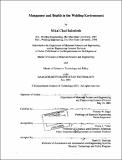Manganese and health in the welding environment
Author(s)
Balmforth, Mikal Chad, 1971-
DownloadFull printable version (2.175Mb)
Other Contributors
Massachusetts Institute of Technology. Technology and Policy Program.
Advisor
Thomas W. Eager.
Terms of use
Metadata
Show full item recordAbstract
There are approximately 0.5 million full-time welders in the U.S., with even more workers welding intermittently. Over the past thirty years there has been increased interest in the effects of welding fume on the health of these workers. Manganese is an essential element in the making of all steel products and steel welding electrodes and is, therefore, present in fume that is generated during welding of these materials. Manganese is essential to humans in small amounts, but in larger amounts it is a neurotoxin and causes manganism, a disease with symptoms similar to Parkinson's disease. Manganese has been reported to cause adverse health effects in industries such as paint production, battery production, and manganese ore mining. Occupational exposure limits for manganese have been developed based on these industries, and the lowest limit, the TLV® established by the American Conference of Governmental Industrial Hygienists, is a source of concern to the welding industry. This thesis attempts to answer the question, "Is the current exposure limit for manganese feasible and does it make sense for the welding industry?" It does this by evaluating whether there is evidence of manganese harm to welders, and evaluating the issues associated with this topic. Calculations show that during an eight-hour shift at current acceptable standards, it is not possible for a welder to ingest enough manganese from the welding environment to cause manganism. There is also evidence that welding fume, which contains iron as well as manganese, carries its own antidote to manganism. A hypothesis suggests that manganese in welding fume, due to affects associated with iron, may not be transferred in harmful amounts across the blood-brain-barrier (BBB). Economic costs to industry would be substantial in meeting the lower exposure limit. The evidence suggests that, at the current permissible level of exposure to total welding fume, the risk of a welder contracting manganism is essentially zero and the economic costs that would be involved with the lower TLV® are not justified.
Description
Thesis (S.M.)--Massachusetts Institute of Technology, Dept. of Materials Science and Engineering; and, (S.M.)--Massachusetts Institute of Technology, Engineering Systems Division, Technology and Policy Program, 2001. Includes bibliographical references (leaves 61-65).
Date issued
2001Department
Massachusetts Institute of Technology. Department of Materials Science and Engineering; Massachusetts Institute of Technology. Engineering Systems Division; Technology and Policy ProgramPublisher
Massachusetts Institute of Technology
Keywords
Materials Science and Engineering., Technology and Policy Program.